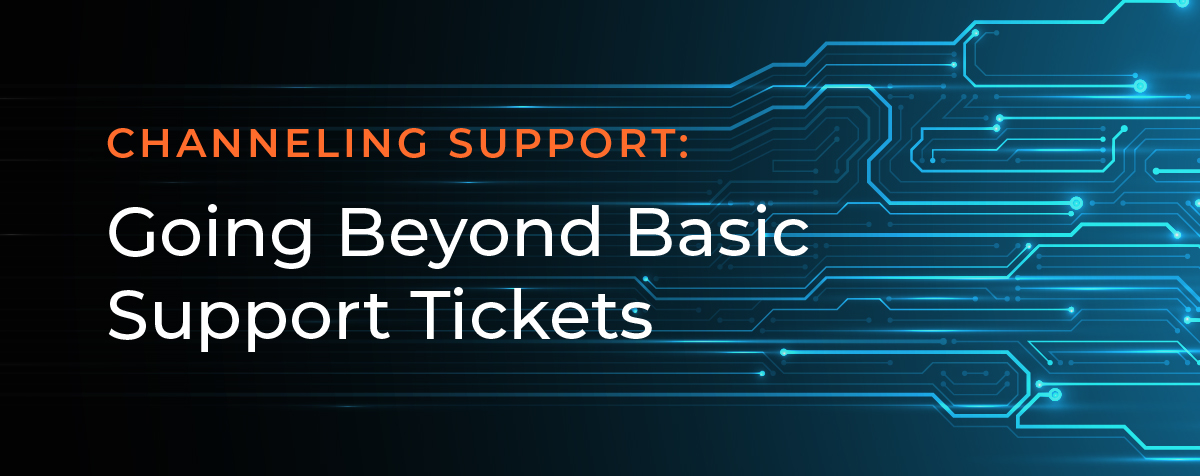Channeling Support: Going beyond basic support tickets

Tech-support is at the heart of any technology company. As a business grows, so does the number of support requests, and the level of customer service/support can make or break a company. The way customers connect and interact with tech-support has been changing over the past decade. Today, customers have become more demanding expecting answers now, not tomorrow or the next day. Long hold times, canned ticket system responses, and email chains are becoming a thing of the past.
Self-Service Web Hosting Support:
When a customer needs help, they no longer pick up the phone. Instead, they’re choosing self-service support. The number one concern of the customer experience is response time. The change to self-service support is a win-win for customer support because it gets answers now and reduces your costs. A Forrester Research and Oracle study “The Total Economic Impact Of Click to Call And Click to Chat” found that providing self-service support can decrease support costs by as much as $11 per call.
How to Offer Self-Service Support on Your Website:
Having clear and concise self-service options on your website is vital. From forums to a knowledge base, documentation, and FAQ, 70% of users expect a company website to include a self-service application.
- Forums: One of the oldest self-service support channels, Forums, offer a moderated, community-based support system. Most forum software provides excellent SEO (Search Engine Optimization) and can provide a wealth of knowledge to your users. The downside to an open forum is moderation. If you do not have the workforce to moderate comments and questions, a forum can quickly go downhill. Our cPanel forum has been growing with the company and currently has over 100,000 threads and over 600,000 messages and is one of the first stops for our customers looking for self-service support.
- Blog: Creating how-to posts and writing about how to troubleshoot common issues on your company blog, and optimizing it for SEO, offers an excellent knowledge base for customers while helping your website get found by search engines. cPanel uses its blog showcasing how-to-articles, new releases, product update articles, tips and tricks, and hosting articles like this one and even blogs like “Anatomy of a Support Ticket” on how to get better support.
- Documentation / FAQ / Knowledge Base: Well written and robust documentation can go along way to self-service support. Let’s face it: documentation can be long and tedious; enhancing documentation by adding tutorial videos can create a better experience. Focusing on common issues facing your customers in a FAQ or an extensive knowledge base can save customers time and your company thousands of dollars in support. cPanel’s Documentation Page is a complete self-service hub incorporating documentation, a knowledge base, our FAQ, video tutorials, and other easy to find resources.
In addition to offering support options on your website, having multiple self-service support channels is becoming more valuable.
Channeling Web Hosting Support on Social Networks:
Self-service support is a great start, but customers have limited patience, and if they don’t find the answers they are looking for, will quickly move to another support channel to find solutions.
In the on-demand world we are currently living in, customers are turning to social for answers. Over the past decade, social networking platforms have been expanding their communication services. In 2018, 67% of customers had used live chat, social media, or texting to contact customer service. Today, customers expect businesses to provide assistance and support via social.
- Facebook: Integrating Facebook Messenger for customer support allows users to communicate with your business in an easily accessible spot for questions and re-engagement. In a recent Facebook Survey of users who message businesses, the majority said, “being able to message a business helps them feel more confident about the brand.” Facebook has doubled down on messenger for business by providing a live chat plugin available for websites. Previously limited to Facebook users, Facebook is making its chatbot styled plugin more accessible by offering guests the ability to leave messages without being logged into the platform. The upcoming update provides a new look and interface that Facebook claims resulted in a 45% increase in customer chats from businesses that were part of pre-release testing.
- Twitter: Twitter’s focus on #hashtags and @tags has made it a great way to reach out for support from brands and businesses. In 2016 Twitter launched their Customer Support features for business, making it easy to use a Twitter account for Customer Service. Many large corporations like T-Mobile, Delta, and others have been using these features since introduced.
- Discord: Perhaps the most valuable social channel for the tech sector, Discord is a proprietary freeware instant messaging and VoIP application primarily used by gamers, educators, and businesses. Discord proudly supports open source and has an eco-system of add-ons and 3rd party contributors like Zendesk that builds a customer support experience within the platform. Discord is cPanel’s community network of choice. We chose Discord because it was a platform alternate to Slack. That’s it. It stuck around because the population on Discord was far more active and engaged than the user base on Slack, by 10x. We continue to use Discord because the Community Team’s motto from day one has been: be where your users are.
- YouTube: It’s no secret that YouTube has become one of the most substantial how-to resources on the web. You can find out how to do anything from web design, car maintenance, to the latest dog grooming tips. Having a robust YouTube channel with solutions to the most common customer pains and questions is a necessity in 2020. Our own YouTube channel has over 100 training and cPanel based videos for our customers to find out more about our product and company.
Social support is a great way to connect with your customers but takes dedicated efforts. Understanding the time involved, the size of your team, and customer base is the first step in deciding if social support is for you. When offering Social based support, it is essential to define your channel and support expectations. Choosing if you’ll use your main channel or create another dedicated support account is the next step. Asking customers to use tags like @support or @help can brand your support requests when using your main channel. Finally, creating a page that clearly defines your social support and support hours will help your customers know what type and when support is available.
Automating Support Channels:
Businesses automate their support channels by integrating tools and bots to help their support staff with redundant tasks. “Letting the robots do the work” has been a catchphrase for automating simple tasks, but as we move into an AI (Artificial Intelligence) based world, we may see a fully automated support staff soon.
- ChatBots: Love or hate them; Chatbots are popping up on just about every website you visit. Perfect for pre-sale questions and communication, as we enter a world transformed by AI, chatbots will become more than simple communication. The only questions remaining are how to implement AI correctly and how to set the conversational tones.
- Zapier: Zapier is a popular solution for automating tasks between applications. Setting up custom Zaps between emails, support desks, CRMs, and Marketing applications can save time and reduce your team’s workload.
- Automated Service Desk: An automated service desk uses AI Virtual Agents to complement human support. Virtual agents aren’t simple one-dimensional chatbots, but are cognitively based on AI and machine learning. A recent study by Milestone Tech found, “Automated Virtual Agents can resolve up to 85% of L0 tickets, and fully 35% of all service desk use cases with no human intervention“. As technology moves forward at breakneck speed, virtual AI support agents like IBM Watson are set to take customer support into the AI world.
Online Training and Multimedia:
Online learning is at its peak in 2020 during the current pandemic, with no signs of slowing down. Leveraging online training for your product can reduce the amount of support needed by a customer.
- Webinars & Tutorials: Webinars are a great tool to showcase new features, product updates, tutorials, and more. Giving your users a chance to interact and ask questions about your product can provide crucial data about your customers. Adding a post-webinar survey to gather information from your customers is also worth its weight in gold. At cPanel, we have embrace virtual learning since 2014 with cPanel University, our online cPanel Certification program. In 2020 we launched cPanel. Live, our virtual broadcast network offering live video webinars and training.
- Online Meetups & Virtual Conferences: Since the current pandemic canceled all in-person meetings, companies have quickly begun using services like Zoom to conduct live Q&A’s, online meetups, and online conferences.
No matter your multimedia offering, it is essential to find the right broadcast channel. Services like Restream.io allow for multi-channel broadcasting to make sure you reach your audience, no matter what platform.
A Final Thought on Channeling Support:
Web Hosting Support is one of the most important parts of running a successful hosting business. Using self-service support options and helping users on social channels, can keep your traditional methods of support like support tickets to a minimum. At cPanel, we are always looking for ways to improve and automate our support channels.
As always, if you have any feedback or comments, please let us know. We are here to help in the best ways we can. You’ll find us on Discord, the cPanel forums, and Reddit.





